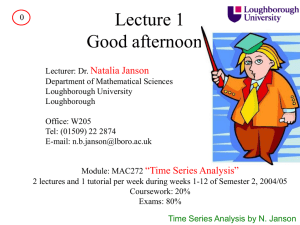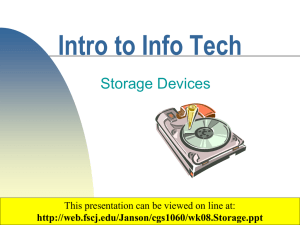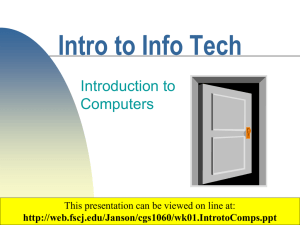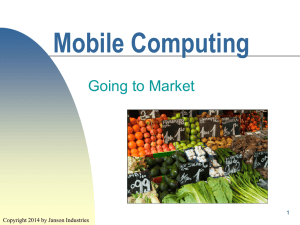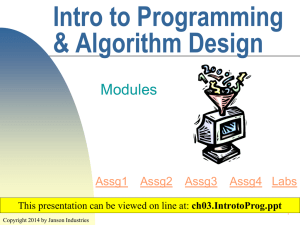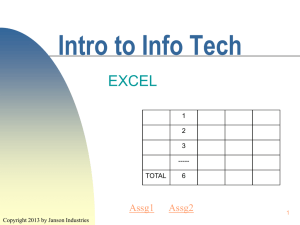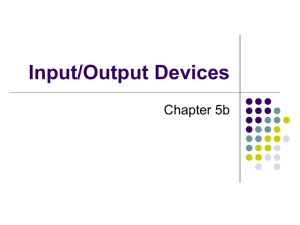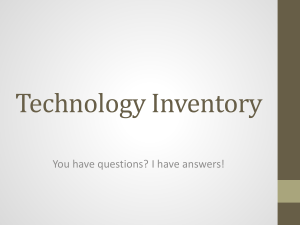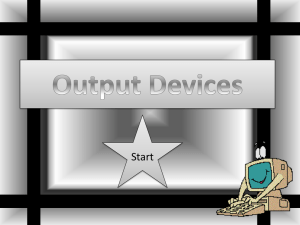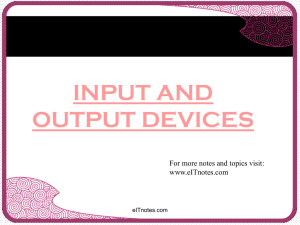Input & Output Equipment
advertisement
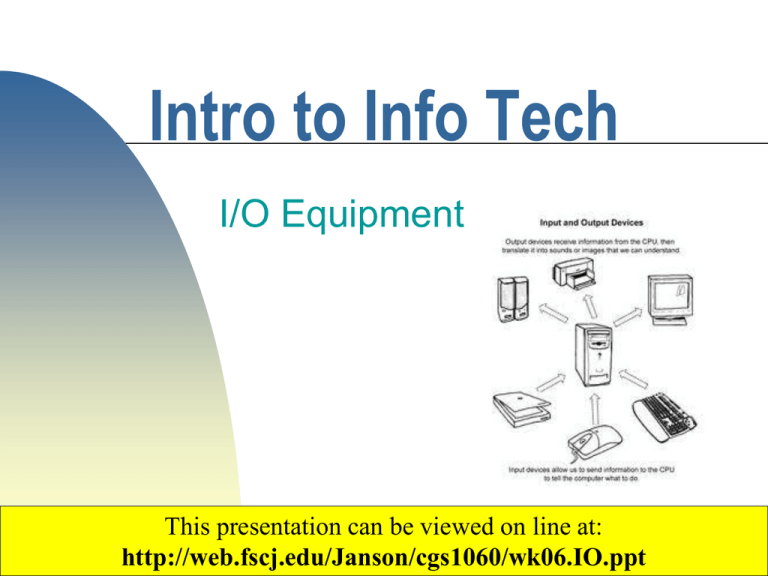
Intro to Info Tech I/O Equipment This presentation can be viewed on line at: Copyright 2003 by http://web.fscj.edu/Janson/cgs1060/wk06.IO.ppt Janson Industries 1 Objectives Explain the various devices Compare and show the relative advantages and disadvantages 2 Copyright 2014 by Janson Industries Input Devices Devices that allow users to enter instructions and data Categories Those commonly used with computers Gaming and media Other 3 Copyright 2014 by Janson Industries Computer Input Devices Require a monitor Two types Keyboard Pointing devices Mouse Trackball Touch pad Pointing stick Light pen Touch screen Pen Copyright 2014 by Janson Industries 4 Keyboards Keys to represent A-Z and 0-9 Additional keys to: Change Alt, function of other keys Ctrl, Shift Perform special functions in apps PageUp, PageDown, Home, Delete, Tab, Esc, F1 –F12, arrows Perform OS function Delete, Windows (shows Start menu), Short Cut Menu key (next to right Ctrl) 5 Copyright 2014 by Janson Industries Keyboards Higher end keyboards will have keys: That perform browser functions Start applications Media controls (forward, back, pause, etc.) And ergonomic features: Palm rest Split keyboard Keys not in a straight line Some have built in scanners S 6 Copyright 2014 by Janson Industries Mouse Use to be: Connected by a wire to SU Left button, right button, scroll wheel Had a little trackball on bottom Getting crazy complicated. Now can have Side buttons Small keyboard Thumb buttons Instead of track ball and wire: Laser Copyright 2014 by Janson Industries or Optical sensors 7 Other Pointing Devices Trackball May also have some buttons Touch pad Flat area that can sense pressure Pointing stick Looks like a pencil eraser stuck in the middle of the keyboard Light pen - like a little flashlight Monitor Duck Copyright 2014 by Janson Industries senses where light is Hunt 8 Other Pointing Devices Touch screens react to human touch Heat sensitive Pressure sensitive Laser grid Electric sensitive Pen input Flat area/screen/paper that can sense and record the pen movement Alternative: pressure sensitive pen that records movement Then Copyright 2014 by Janson Industries download from pen to computer 9 Gaming and Media Lots of specialty devices – two handed device, with buttons, wheels, sticks. Talks to console. Gamepad Joystick – stick with buttons on base wheel – may have buttons and a footpad with pedals Steering guns – fancy flashlight or a motion sensing device Light pad – flat device (can be hard or pliable) that senses pressure Dance Motion Copyright 2014 by Janson Industries sensing device – like a Wii remote 10 Other Input Devices Audio Input Devices (require a sound card) Microphone For voice input, need voice recognition s/w MIDI (musical instrument digital interface) devices Electronic piano Electric guitar Other computers PDAs, Smart Phones, etc. 11 Copyright 2014 by Janson Industries Other Input Devices Graphic Input Devices Digital Camera Can store a small amount Can use memory cards Video Cameras Can be used to do VOIP, video conferencing, as a web cam, etc. Need extra s/w to do these things 12 Copyright 2014 by Janson Industries Other Input Devices Scanners/readers scanners – convert anything scanned into an image Optical readers: Optical OCR (Optical Character Recognition) • Recognizes numbers and letters OMR (Optical Mark Recognition) • Like a Scantron machine Bar Copyright 2014 by Janson Industries Code readers, lots of kinds MaxiCode Datamatrix QR 13 Bar Codes Standard is one dimensional Lots of different standards Code MaxiCode (created by UPS) 93 chars max Data Matrix 2335 39, code 93, code 128 alphanumeric chars QR (Quick Response) can store 7,089 numeric chars 4,296 alphanumeric chars 2,953 bytes Copyright 2014 by Janson Industries 14 Bar Codes Originally created to contain product/tracking info Being used to store much more info URLs, phone numbers User scans the QR Code with phone The phone's browser is launched and goes to the URL The phone dials the number QR reader app in Android OS 15 Copyright 2014 by Janson Industries Other Input Devices Scanners/readers RFID (Radio Frequency IDentification) Very hot technology Magnetic Stripe Card readers A device that swipes a credit card-like object MICR (Magnetic Ink Character Reader) What industry uses this? 16 Copyright 2014 by Janson Industries Other Input Devices Biometric Devices Use other input devices (scanners, microphones, etc.) and extra s/w to detect physiological characteristics Retinal scanner Iris scanner Fingerprint scanner Face recognition Voice recognition Signature verification 17 Copyright 2014 by Janson Industries Output Devices Devices that allow users to receive output Categories of Devices Displays Printers Other 18 Copyright 2014 by Janson Industries Output Devices Types of output Text Graphics Audio Video One of the ways to compare output devices is by the types of output they support 19 Copyright 2014 by Janson Industries Displays TV like viewing screen that can display text, graphics and video Most allow control over brightness, contrast, etc. Monitor – a separate device that connects to the system unit Compared by their: Screen size, resolution, response time (aka refresh rate), brightness, contrast 20 ratio Copyright 2014 by Janson Industries Monitors Most are: 15-23 inches diagonally Laptops 8-20 PDAs 3-4 Desktop publishing systems will have monitors 30-40 inches Beware of monitor vs. viewable size 21 Copyright 2014 by Janson Industries Monitors Resolution measured in Pixels and lines Expressed as the number of pixels per line by the number of lines from the top to bottom of the screen Eg. 1280X1024 What's a Pixel? 22 Copyright 2014 by Janson Industries Monitors Dot pitch Distance between pixels Contrast Ratio Range of color intensity Compares the screens brightest white to it's darkest black Higher the contrast, better the color 23 Copyright 2014 by Janson Industries Monitors Lots of different types of monitors LCD (liquid crystal display) aka flat screen Built for a specific resolution Bigger the screen, higher the resolution • 17 in usually 1280X1024 • 20 in usually 1600X1200 Response (time to change a pixel/bit) is 5 to 16 millisecs 24 Copyright 2014 by Janson Industries Monitors Brightness measured in nits Nit = 1 candle per square meter Candle = 1/60 of the luminous intensity per square centimeter of a black body radiating at the temperature of 2,046 degrees Kelvin All you have to know is "more nits = brighter picture" Dot pitch should be < .28 mm Static contrast ratios range from 500:1 to 2000:1 Copyright 2014 by Janson Industries 25 Monitors Plasma Not as common as LCDs (for computers) Uses a gas instead of liquid Heavier than LCD Larger screen sizes than LCDs Richer colors More expensive 26 Copyright 2014 by Janson Industries Monitors CRT (Cathode Ray Tube) Cheaper than LCDs Use more electricity than LCDs Resolution Range Dot can be changed by OS from 2048X1536 to 1280X1024 pitch should be < .27 Refresh rate How many times per sec image is changed 68 Hz means 68 times per sec Larger the number, less flicker 27 Copyright 2014 by Janson Industries Printers Produces text and graphics on some medium Paper, transparency, film Some have a camera dock or a memory card slot Images don't have to be transferred Lots of different types Can be categorized as Impact or Nonimpact 28 Copyright 2014 by Janson Industries Impact Printers Component strikes the medium Well really the ink ribbon Don't see many anymore Line printers had solid font text Typewriter like keys A daisywheel A selectric ball Dot matrix Used for printing on tractor feed paper • Auto repair shops, bank tellers 29 Copyright 2014 by Janson Industries Non-impact Printers Spray, attract ink or burn Compared by the Medium sizes accommodated 8.5X11.5, 3X5, 4X6 Print resolution DPI (dots per inch) Speed PPM (page per minute) Usually different PPM for color vs. B&W printing 30 Copyright 2014 by Janson Industries Non-impact Printers Ink Jet print head has two cartridges and little nozzles Relatively Ink's cheap (<$100) expensive! Supports many paper sizes 1200-4800 6 dpi to 33 ppm 31 Copyright 2014 by Janson Industries Non-impact Printers Laser More expensive ($200 - $100,000) Uses powdered ink called toner Supports many paper sizes 1200-2400 Faster dpi than ink jet For home 8 to 35 ppm Business 150 ppm 32 Copyright 2014 by Janson Industries Non-impact Printers Photo Printer High quality Wide range of sizes More expensive May let you edit picture Often, can print without a computer connection 33 Copyright 2014 by Janson Industries Non-impact Printers Thermal Burns Wide special paper range of capability – poor quality, like gas receipt High end – good quality Cheapos Plotters Good for diagrams, charts Large format printers Blueprints, signs, posters 34 Copyright 2014 by Janson Industries Other Output Devices For sound: Speakers Headphones Ear buds Voice output uses speakers and special s/w The number you have dialed 8-1-24-6-6-2 35 Copyright 2014 by Janson Industries Other Output Devices Fax Fax modem allows computer to send faxes S/W need to convert computer files to faxes 36 Copyright 2014 by Janson Industries Other Output Devices Projector Displays anything on the computer screen Large devices like in the classroom But there are small portable ones too Not as good resolution 37 Copyright 2014 by Janson Industries What do you need? How do you decide what to buy? What do you want to do with the computer? This dictates application s/w Application s/w dictates h/w: Peripherals 38 Copyright 2014 by Janson Industries Points to Remember Input and output devices called peripheral devices Connect to the system unit either with a cable or wirelessly Infrared requires line of sight Radio (e.g. Bluetooth) Enable users to enter instructions and data and receive output 39 Copyright 2014 by Janson Industries
